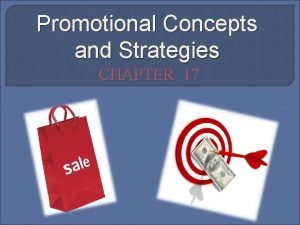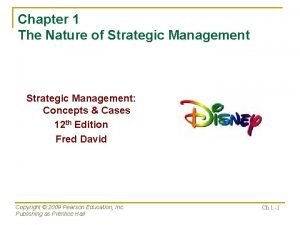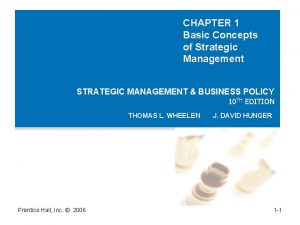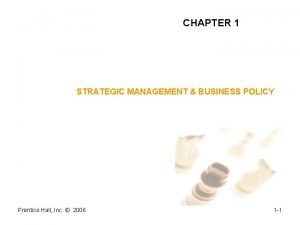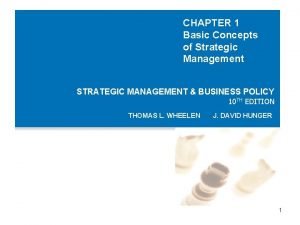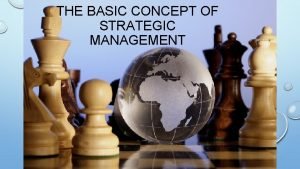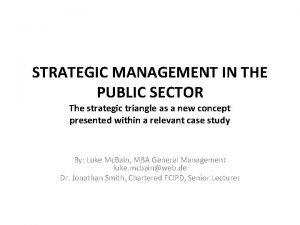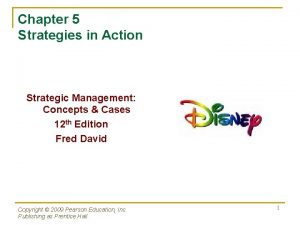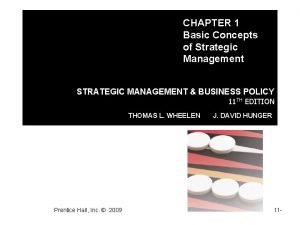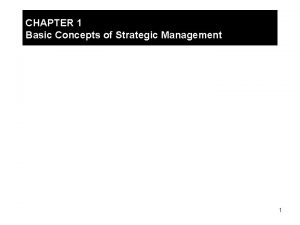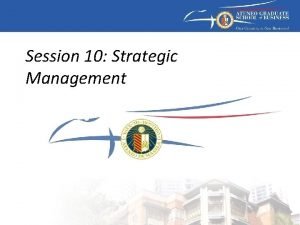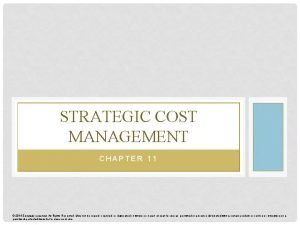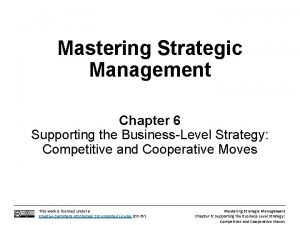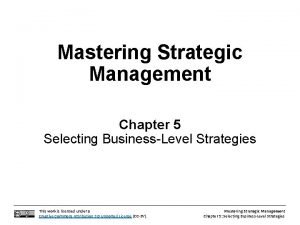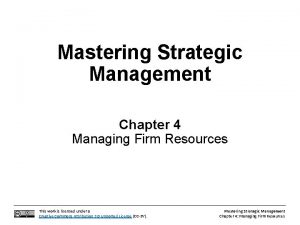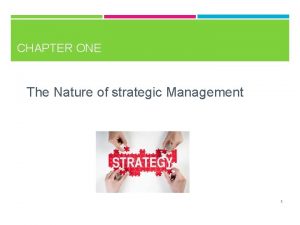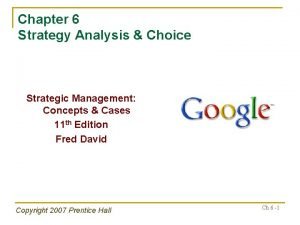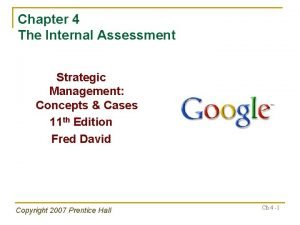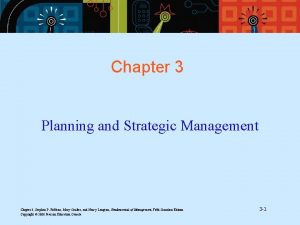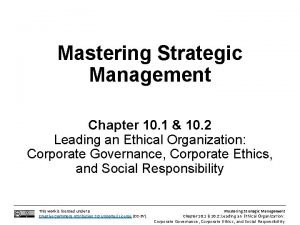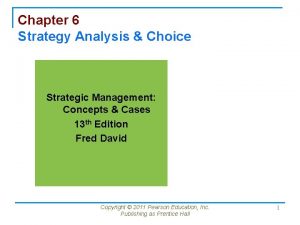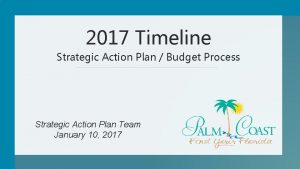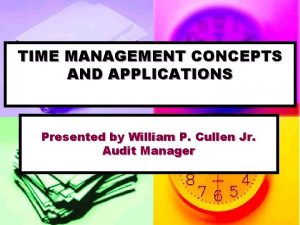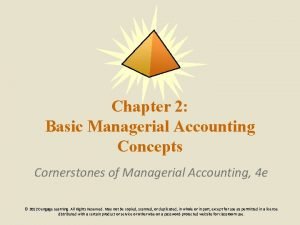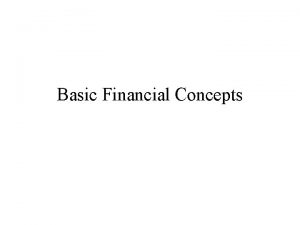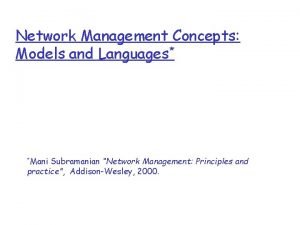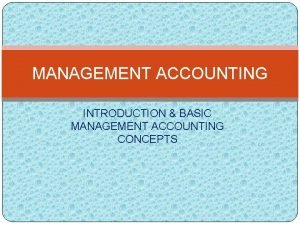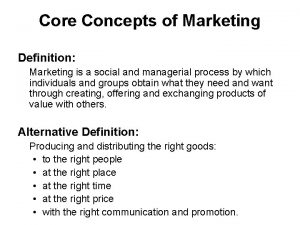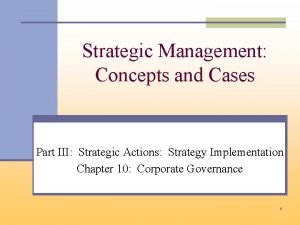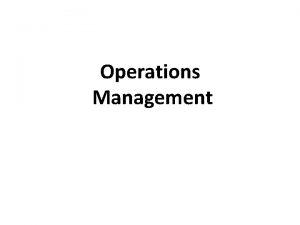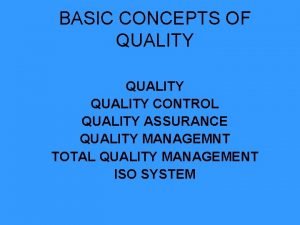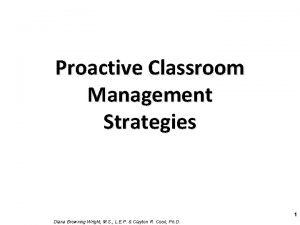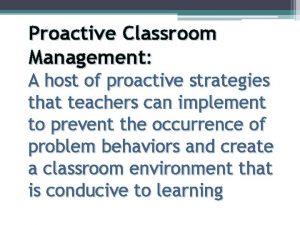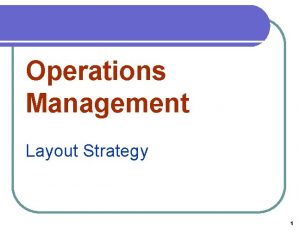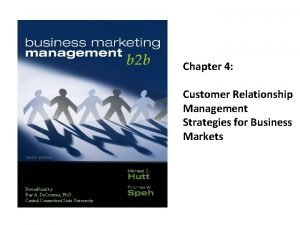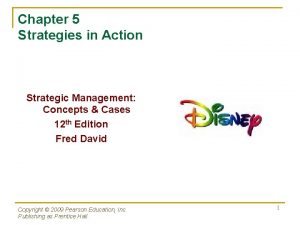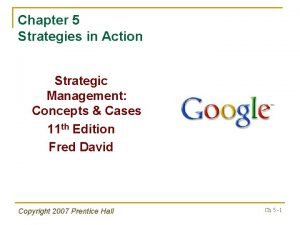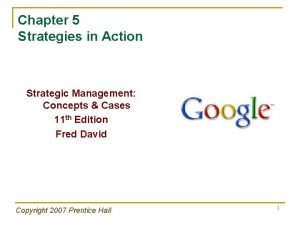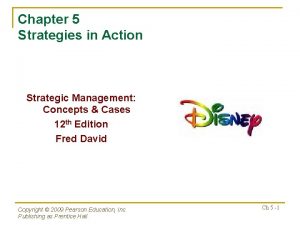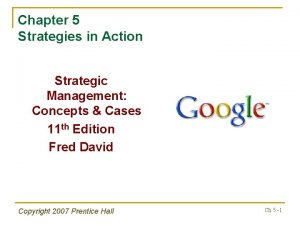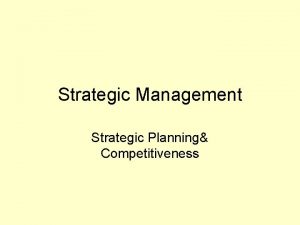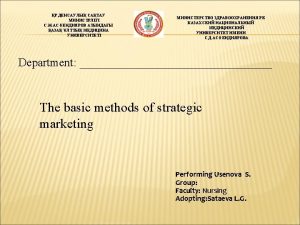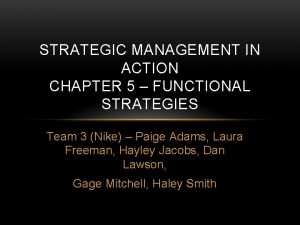Chapter 5 Strategies in Action Strategic Management Concepts









































































- Slides: 73

Chapter 5 Strategies in Action Strategic Management: Concepts & Cases 12 th Edition Fred David Copyright © 2009 Pearson Education, Inc. Publishing as Prentice Hall 1

Long-Term Objectives – §Quantifiable §Measurable §Realistic §Understandable §Challenging Copyright © 2009 Pearson Education, Inc. Publishing as Prentice Hall 2

Long-Term Objectives – §Hierarchical §Obtainable §Congruent/go well together §Timeline Copyright © 2009 Pearson Education, Inc. Publishing as Prentice Hall 3

Objectives n Objectives are commonly stated in terms such as growth in assets, growth in sales, profitability, market share, degree and nature of diversification, and so on. Copyright © 2009 Pearson Education, Inc. Publishing as Prentice Hall 4

Varying Performance Measures by Organizational Level Copyright © 2009 Pearson Education, Inc. Publishing as Prentice Hall 5

Financial vs. Strategic Objectives Financial Objectives §Growth in revenues §Growth in earnings §Higher dividends §Higher profit margins §Higher earnings per share §Improved cash flow Copyright © 2009 Pearson Education, Inc. Publishing as Prentice Hall 6

Strategic objectives n 1. 2. 3. 4. 5. 6. n such as: larger market share, quicker on-time delivery than rivals, quicker design-to-market times than rivals, lower costs than rivals, higher product quality than rivals, wider geographic coverage than rivals, etc. 3. There is frequently a tradeoff/exchange between financial and strategic objectives. Copyright © 2009 Pearson Education, Inc. Publishing as Prentice Hall 7

Not Managing by Objective §Strategists should avoid the following alternative ways of “not managing by objectives. ” §Managing by Extrapolation – “If it ain’t broke (if you don not have problem), don’t fix it. ” §Managing by Crisis – The true measure of a good strategist is the ability to fix problems §Managing by Subjectives – “Do your own thing, the best way you know how. ” §Managing by Hope – The future is full of uncertainty and if first you don’t succeed, then you may on the second or third try. Copyright © 2009 Pearson Education, Inc. Publishing as Prentice Hall 8

The Balanced Scorecard Robert Kaplan & David Norton – § The balanced scorecard is a strategy evaluation and control technique that derives its name from the perceived need of firms to “balance” financial measures, which are oftentimes used exclusively in strategy evaluation and control with nonfinancial measures such as product quality and customer service. Copyright © 2009 Pearson Education, Inc. Publishing as Prentice Hall 9

The Balanced Scorecard n A balanced scorecard for a firm is simply a listing of all key objectives to work towards along with an associated time dimension of when each objective is to be accomplished, as well as a primary responsibility or contact person, department, or division for each objective. Copyright © 2009 Pearson Education, Inc. Publishing as Prentice Hall 10

BSC performance evaluation depends on four consequential stages n n 1 - Specifying institutional objectives. 2 - Translating the institutional objectives to analytical performance plans. 3 - Specifying the responsibility centers. 4 - Developing the performance measurement indicators, which include: indicators of effectiveness, efficiency, productivity, and quality Copyright © 2009 Pearson Education, Inc. Publishing as Prentice Hall 11

BSC analysis method constitutes four perspectives as follows n n Financial Perspective. This is related to meet the expectations of the shareholders. Customer Perspective. This is related to achieve customer satisfaction. Learning and Growth Perspective. This is related to business ability to learn and grow to be ready for future. Internal Process Perspective. The internal process should be efficient and effective. Copyright © 2009 Pearson Education, Inc. Publishing as Prentice Hall 12

Copyright © 2009 Pearson Education, Inc. Publishing as Prentice Hall 13

Types of Strategies Corp Level A Large Company Division Level Functional Level Operational Level Copyright © 2009 Pearson Education, Inc. Publishing as Prentice Hall 14

Types of Strategies company A small Company Functional Level Operational Level Copyright © 2009 Pearson Education, Inc. Publishing as Prentice Hall 15

Strategies in Action Vertical Integration Strategies • • • Forward integration Backward integration Horizontal integration Copyright © 2009 Pearson Education, Inc. Publishing as Prentice Hall 16

Strategies in Action Forward Integration Defined • Gaining ownership or increased control over distributors or retailers Copyright © 2009 Pearson Education, Inc. Publishing as Prentice Hall Example • General Motors is acquiring 10% of its dealers. 17

Strategies in Action Guidelines for Forward Integration ü ü ü Present distributors are expensive, unreliable, or incapable of meeting firm’s needs Availability of quality distributors is limited When firm competes in an industry that is expected to grow markedly Advantages of stable production are high Present distributor have high profit margins Copyright © 2009 Pearson Education, Inc. Publishing as Prentice Hall 18

Strategies in Action Backward Integration Defined • Seeking ownership or increased control of a firm’s suppliers Copyright © 2009 Pearson Education, Inc. Publishing as Prentice Hall Example • Motel 8 acquired a furniture manufacturer. 19

Strategies in Action Guidelines for Backward Integration ü ü ü When present suppliers are expensive, unreliable, or incapable of meeting needs Number of suppliers is small and number of competitors large High growth in industry sector Firm has both capital and human resources to manage new business Advantages of stable prices are important Present supplies have high profit margins Copyright © 2009 Pearson Education, Inc. Publishing as Prentice Hall 20

Strategies in Action Horizontal Integration Example Defined • • Hilton recently acquired Promus. Seeking ownership or increased control over competitors Copyright © 2009 Pearson Education, Inc. Publishing as Prentice Hall 21

Strategies in Action Guidelines for Horizontal Integration Firm can gain monopolistic characteristics without being challenged by federal government ü Competes in growing industry ü Increased economies of scale provide major competitive advantages ü Faltering/losing due to lack of managerial expertise or need for particular resources ü Copyright © 2009 Pearson Education, Inc. Publishing as Prentice Hall 22

Strategies in Action Intensive Strategies • • • Market penetration Market development Product development Copyright © 2009 Pearson Education, Inc. Publishing as Prentice Hall 23

Strategies in Action Market Penetration Defined • Seeking increased market share for present products or services in present markets through greater marketing efforts Copyright © 2009 Pearson Education, Inc. Publishing as Prentice Hall Example • Ameritrade, the online broker, tripled its annual advertising expenditures to $200 million to convince people they can make their own investment decisions. 24

Strategies in Action Guidelines for Market Penetration Current markets not saturated ü Usage rate of present customers can be increased significantly ü Market shares of competitors declining while total industry sales increasing ü Increased economies of scale provide major competitive advantages ü Copyright © 2009 Pearson Education, Inc. Publishing as Prentice Hall 25

Strategies in Action Market Development Defined Example • • Introducing present products or services into new geographic area Copyright © 2009 Pearson Education, Inc. Publishing as Prentice Hall Khuzendar Tiles maker introduce his product to Gulf markets. 26

Strategies in Action Guidelines for Market Development ü ü ü New channels of distribution that are reliable, inexpensive, and good quality Firm is very successful at what it does Untapped or unsaturated markets Capital and human resources necessary to manage expanded operations Excess production capacity Basic industry rapidly becoming global Copyright © 2009 Pearson Education, Inc. Publishing as Prentice Hall 27

Strategies in Action Product Development Example Defined • Seeking increased sales by improving present products or services or developing new ones Copyright © 2009 Pearson Education, Inc. Publishing as Prentice Hall • • Apple developed the G 4 chip that runs at 500 megahertz. Khuzendar Tiles maker introduce Ceramic as a new product. 28

Strategies in Action Guidelines for Product Development ü ü ü Products in maturity stage of life cycle Competes in industry characterized by rapid technological developments Major competitors offer better-quality products at comparable prices Compete in high-growth industry Strong research and development capabilities Copyright © 2009 Pearson Education, Inc. Publishing as Prentice Hall 29

Strategies in Action Diversification Strategies • • • Concentric diversification Conglomerate diversification Horizontal diversification Copyright © 2009 Pearson Education, Inc. Publishing as Prentice Hall 30

Strategies in Action Concentric Diversification Example Defined • Adding new, but related, products or services Copyright © 2009 Pearson Education, Inc. Publishing as Prentice Hall • National Westminister Bank PLC in Britain bought the leading British insurance company, Legal & General Group PLC. 31

Strategies in Action Guidelines for Concentric Diversification ü ü ü Competes in no- or slow-growth industry Adding new & related products increases sales of current products New & related products offered at competitive prices Current products are in decline stage of the product life cycle Strong management team Copyright © 2009 Pearson Education, Inc. Publishing as Prentice Hall 32

Strategies in Action Conglomerate Diversification Example Defined • Adding new, unrelated products or services Copyright © 2009 Pearson Education, Inc. Publishing as Prentice Hall • Consultant Construction Engineering acquired El-Awda Bisects Co. 33

Strategies in Action Guidelines for Conglomerate Diversification Declining annual sales and profits ü Capital and managerial talent to compete successfully in a new industry ü Financial synergy between the acquired and acquiring firms ü Exiting markets for present products are saturated ü Copyright © 2009 Pearson Education, Inc. Publishing as Prentice Hall 34

Strategies in Action Horizontal Diversification Defined • Adding new, unrelated products or services for present customers Copyright © 2009 Pearson Education, Inc. Publishing as Prentice Hall Example • The El-Awda Co. merging with Palestinian Islamic Bank. 35

Strategies in Action Guidelines for Horizontal Diversification Revenues from current products/services would increase significantly by adding the new unrelated products ü Highly competitive and/or no-growth industry w/low margins and returns ü Present distribution channels can be used to market new products to current customers ü New products have counter cyclical sales patterns compared to existing products ü Copyright © 2009 Pearson Education, Inc. Publishing as Prentice Hall 36

Strategies in Action Defensive Strategies • • Joint venture Retrenchment Divestiture Liquidation Copyright © 2009 Pearson Education, Inc. Publishing as Prentice Hall 37

Strategies in Action Joint Venture Defined • Two or more sponsoring firms forming a separate organization for cooperative purposes Copyright © 2009 Pearson Education, Inc. Publishing as Prentice Hall Example • Lucent Technologies and Philips Electronic NV formed Philips Consumer Communications to make and sell telephones. 38

Joint Venture n n Joint venture is a popular strategy that occurs when two or more companies form a temporary partnership or consortium for the purpose of capitalizing on some opportunity. Other types of cooperative arrangements include R&D partnerships, cross-distribution agreements, cross-licensing agreements, cross-manufacturing agreements, and jointbidding consortia. Copyright © 2009 Pearson Education, Inc. Publishing as Prentice Hall 39

Joint Venture n Joint ventures and cooperative arrangements are being used increasingly because they allow companies to improve communications and networking, to globalize operations and minimize risk. Copyright © 2009 Pearson Education, Inc. Publishing as Prentice Hall 40

Joint Venture n Many, if not most, organizations pursue a combination of two or more strategies simultaneously, but a combination strategy can be exceptionally risky if carried too far. No organization can afford to pursue all the strategies that might benefit the firm. Difficult decisions must be made. Priorities must be established. Organizations, like individuals, have limited resources. Both organizations and individuals must choose among alternative strategies and avoid excess indebtedness. Copyright © 2009 Pearson Education, Inc. Publishing as Prentice Hall 41

Joint ventures may fail when: n n Managers who must collaborate regularly are not involved in the venture. The venture may benefit partnering companies but not the customers. Both partners may not support the venture equally. The venture competes with one of the partners Copyright © 2009 Pearson Education, Inc. Publishing as Prentice Hall 42

Joint ventures are especially effective when: n n n A privately owned organization forms one with a public organization. A domestic organization works with a foeign company. The distinct competencies of the firms complement each other especially well. Some project is potentially profitable but requires much risk. Two or more smaller firms wish to compete against a larger firm. There is a need to introduce a new technology quickly. Copyright © 2009 Pearson Education, Inc. Publishing as Prentice Hall 43

Strategies in Action Guidelines for Joint Venture ü ü ü Combination of privately held and publicly held can be synergistically combined Domestic forms joint venture with foreign firm, can obtain local management to reduce certain risks Distinctive competencies of two or more firms are complementary Overwhelming resources and risks where project is potentially very profitable (e. g. , Alaska pipeline) Two or more smaller firms have trouble competing with larger firm A need exists to introduce a new technology quickly Copyright © 2009 Pearson Education, Inc. Publishing as Prentice Hall 44

Strategies in Action Retrenchment (turnaround) Defined • Regrouping through cost and asset reduction to reverse declining sales and profit. Sometimes it is called turnaround or reorganizational strategy. Copyright © 2009 Pearson Education, Inc. Publishing as Prentice Hall Example • El-Awda sold off a land 4 apartments to raise cash needed. It introduce expense effective control system. 45

Strategies in Action Guidelines for Retrenchment ü ü ü Firm has failed to meet its objectives and goals consistently over time but has distinctive competencies Firm is one of the weaker competitors Inefficiency, low profitability, poor employee morale, and pressure from stockholders to improve performance. When an organization’s strategic managers have failed Very quick growth to large organization where a major internal reorganization is needed. Copyright © 2009 Pearson Education, Inc. Publishing as Prentice Hall 46

Strategies in Action Divestiture Defined • Selling a division or part of an organization Copyright © 2009 Pearson Education, Inc. Publishing as Prentice Hall Example • Harcourt General, the large US publisher, is selling its Neiman Marcus division. 47

Strategies in Action Guidelines for Divestiture ü ü ü When firm has pursued retrenchment but failed to attain needed improvements When a division needs more resources than the firm can provide When a division is responsible for the firm’s overall poor performance When a division is a misfit with the organization When a large amount of cash is needed and cannot be obtained from other sources. Copyright © 2009 Pearson Education, Inc. Publishing as Prentice Hall 48

Strategies in Action Liquidation Defined • Selling all of a company’s assets, in parts, for their tangible worth Copyright © 2009 Pearson Education, Inc. Publishing as Prentice Hall Example • El-Ameer Block factory sold all its assets and ceased business. 49

Strategies in Action Guidelines for Liquidation When both retrenchment and divestiture have been pursued unsuccessfully ü If the only alternative is bankruptcy, liquidation is an orderly alternative ü When stockholders can minimize their losses by selling the firm’s assets ü Copyright © 2009 Pearson Education, Inc. Publishing as Prentice Hall 50

Mergers and acquisitions n n n Mergers and acquisitions are two commonly used ways to pursue strategies. A merger occurs when two organizations of about equal size unite to form one enterprise. An acquisition occurs when a large organization purchases (acquires) a smaller firm or vice versa. Copyright © 2009 Pearson Education, Inc. Publishing as Prentice Hall 51

Reasons for mergers and acquisitions 1. 2. 3. 4. 5. 6. 7. 8. a. To provide improved capacity utilization b. To make better use of an existing sales force. c. To reduce managerial staff. d. To gain economies of scale. e. To smooth out seasonal trends in sales. f. To gain access to new suppliers, distributors, customers, products, and creditors. g. To gain new technology. h. To reduce tax obligations. Copyright © 2009 Pearson Education, Inc. Publishing as Prentice Hall 52

Mergers and acquisitions may fail n 1. 2. 3. 4. 5. 6. 7. 8. 9. due to the following reasons: a. Integration difficulties b. Inadequate evaluation of target c. Large debt d. Inability to achieve synergy e. Too much diversification f. Managers overly focused on acquisitions g. Too large of an acquisition h. Difficulty integrating different cultures i. Reduced employee morale due to layoffs and relocations Copyright © 2009 Pearson Education, Inc. Publishing as Prentice Hall 53

Leveraged Buyouts (LBOs) n n 1. An LBO occurs when a corporation’s shareholders are bought out (hence buyout) by the company’s management and other private investors using borrowed funds (hence leveraged). 2. Besides trying to avoid a hostile takeover, other reasons for the initiation of an LBO by senior management are that particular divisions do not fit into an overall corporate strategy, must be sold to raise cash, or receive an attractive offering price. A LBO takes a corporation private Copyright © 2009 Pearson Education, Inc. Publishing as Prentice Hall 54

First Mover Advantages n n 1. First mover advantages refers to the benefits a firm may achieve by entering a new market or developing a new product or service prior to rival firms. 2. The advantages of being a first mover include securing access to rare resources, gaining new knowledge of key factors and issues, and carving out market share and a position that is easy to defend and costly for rival firms overtake. Copyright © 2009 Pearson Education, Inc. Publishing as Prentice Hall 55

Outsourcing q q Business-Process Outsourcing (BPO): Companies take over functional operations such as human resources, information systems, and marketing for other firms. Outsourcing can be less expensive, can allow firms to focus on core businesses, and enables firms to provide better services. Copyright © 2009 Pearson Education, Inc. Publishing as Prentice Hall 56

Michael Porter’s Generic Strategies Cost Leadership Strategies (Low-Cost & Best-Value) Differentiation Strategies Focus Strategies (Low-Cost Focus & Best-Value Focus) Copyright © 2009 Pearson Education, Inc. Publishing as Prentice Hall 57

Copyright © 2009 Pearson Education, Inc. Publishing as Prentice Hall 58

Michael Porter’s Generic Strategies n n Cost leadership emphasizes producing standardized products at a very low per-unit cost for consumers who are price-sensitive. There are two types of cost leadership strategies. a. A low-cost strategy offers products to a wide range of customers at the lowest price available on the market. b. A best-value strategy offers products to a wide range of customers at the best price-value available on the market. Copyright © 2009 Pearson Education, Inc. Publishing as Prentice Hall 59

Cost leadership n Striving to be the low-cost producer in an industry can be especially effective when the market is composed of many price-sensitive buyers, when there are few ways to achieve product differentiation, when buyers do not care much about differences from brand to brand, or when there a large number of buyers with significant bargaining power. Copyright © 2009 Pearson Education, Inc. Publishing as Prentice Hall 60

Cost leadership n n The basic idea behind a cost leadership strategy is to underprice competitors or offer a better value and thereby gain market share and sales, driving some competitors out of the market entirely. 5. To successfully employ a cost leadership strategy, firms must ensure that total costs across the value chain are lower than that of the competition. This can be accomplished by: a. performing value chain activities more efficiently than competition, and b. eliminating some cost-producing activities in the value chain. Copyright © 2009 Pearson Education, Inc. Publishing as Prentice Hall 61

Differentiation n Differentiation is aimed at producing products that are considered unique. This strategy is most powerful with the source of differentiation is especially relevant to the target market Copyright © 2009 Pearson Education, Inc. Publishing as Prentice Hall 62

Differentiation n n A successful differentiation strategy allows a firm to charge higher prices for its products to gain customer loyalty because consumers may become strongly attached to the differentiation features. 3. A risk of pursuing a differentiation strategy is that the unique product may not be valued highly enough by customers to justify the higher price. Copyright © 2009 Pearson Education, Inc. Publishing as Prentice Hall 63

Differentiation n Common organizational requirements for a successful differentiation strategy include strong coordination among the R&D and marketing functions and substantial amenities to attract scientists and creative people. Copyright © 2009 Pearson Education, Inc. Publishing as Prentice Hall 64

Focus n n 1. Focus means producing products and services that fulfill the needs of small groups of consumers. 2. There are two types of focus strategies. a. A low-cost focus strategy offers products or services to a small range (niche) of customers at the lowest price available on the market. b. A best-value focus strategy offers products to a small range of customers at the best price-value available on the market. This is sometimes called focused differentiation. Copyright © 2009 Pearson Education, Inc. Publishing as Prentice Hall 65

Focus n Focus strategies are most effective when the niche is profitable and growing, when industry leaders are uninterested in the niche, when industry leaders feel pursuing the niche is too costly or difficult, when the industry offers several niches, and when there is little competition in the niche segment. Copyright © 2009 Pearson Education, Inc. Publishing as Prentice Hall 66

Copyright © 2009 Pearson Education, Inc. Publishing as Prentice Hall 67

Copyright © 2009 Pearson Education, Inc. Publishing as Prentice Hall 68

Review n n How does strategy formulation differ for a small versus large organization? For a for-profit versus a nonprofit organization? Strategy formulation is conceptually the same for both small and large organizations. However, for large firms, there are more variables to include in both the external and internal audits. The process is usually more formal in a large firm. Copyright © 2009 Pearson Education, Inc. Publishing as Prentice Hall 69

Review n n Give recent examples of forward integration, backward integration, and horizontal integration. Forward integration means purchasing or developing a distributor for a product. For instance, Nike now has its own retail stores in various locations. Backward integration means owning a supply source for production. For instance, recently garment producers in Sri Lanka began seeking to purchase textile mills in India. Horizontal integration means acquiring like operations. For instance, a hospital group may purchase another hospital. Copyright © 2009 Pearson Education, Inc. Publishing as Prentice Hall 70

Review n n Do you think hostile takeovers are unethical? Why or why not? It can best be argued that hostile takeovers are ethical. Usually, only weak companies face hostile takeovers, and, typically, shareholders and customers of the company benefit from the new organization. Most employees and managers benefit, too, but some employees and top managers usually lose their jobs when the takeover is consummated. From this angle, some students may argue that hostile takeovers are unethical. Copyright © 2009 Pearson Education, Inc. Publishing as Prentice Hall 71

Review n n Why is it not advisable to pursue too many strategies at once? Organizational resources are spread too thin when more than a few strategies are pursued at the same time. All organizations have limited resources. No organization can pursue all the strategies that may benefit the firm. Similarly, no individual can take on an unlimited amount of debt to obtain goods and services. No more than a few strategies can be financed, marketed, and managed effectively at the same time. Some practitioners say only a single strategy should be pursued at a given time by a single organization. Copyright © 2009 Pearson Education, Inc. Publishing as Prentice Hall 72

Review n n What strategies are best for turbulent, high-velocity markets? Firms in this type of market have a choice of whether to react, anticipate, or lead the market in terms of its own strategies. These choices are reflected in Figure 5 -4. If a firm primarily responds to the turbulent market by responding to changes in the industry defensively. The react-to-change strategy would not be as effective as the anticipate change strategy, which entails devising and following through with plans for dealing with the expected changes. Ideally, a firm will strive to lead the market, by pioneering new and better technologies and products. Copyright © 2009 Pearson Education, Inc. Publishing as Prentice Hall 73
 Strategies in action
Strategies in action Chapter 17 promotional concepts and strategies
Chapter 17 promotional concepts and strategies Types of promotion
Types of promotion Benefits of strategic management
Benefits of strategic management Basic concepts of strategic management
Basic concepts of strategic management Basic concepts of strategic management
Basic concepts of strategic management Basic concept of strategic management
Basic concept of strategic management Basic concept of strategic management
Basic concept of strategic management Political management in strategic triangle
Political management in strategic triangle Strategies in action
Strategies in action Basic concepts of strategic management
Basic concepts of strategic management Basic concepts of strategic management
Basic concepts of strategic management Parenting strategy in strategic management
Parenting strategy in strategic management Horizontal diversification
Horizontal diversification Functional strategies in strategic management
Functional strategies in strategic management Industrial organization model of above average returns
Industrial organization model of above average returns Tows matrix
Tows matrix Haley strategic family therapy
Haley strategic family therapy Strategic fit vs strategic intent
Strategic fit vs strategic intent Strategic complements and substitutes examples
Strategic complements and substitutes examples Prentice hall physical science concepts in action
Prentice hall physical science concepts in action Pearson physical science concepts in action
Pearson physical science concepts in action Chemical property definition
Chemical property definition Pearson physical science concepts in action
Pearson physical science concepts in action Kuiper belt def
Kuiper belt def Cues to action are strategies to activate readiness.
Cues to action are strategies to activate readiness. Chapter 11 strategic cost management
Chapter 11 strategic cost management Strategic management chapter 6
Strategic management chapter 6 Strategic management chapter 5
Strategic management chapter 5 Strategic management chapter 4
Strategic management chapter 4 Strategic management nature
Strategic management nature Strategic management chapter 9
Strategic management chapter 9 Strategic management chapter 7
Strategic management chapter 7 Management issues central to strategy implementation
Management issues central to strategy implementation Implementing strategies: management and operations issues
Implementing strategies: management and operations issues Chapter 6 strategy analysis and choice
Chapter 6 strategy analysis and choice Strategic management ppt chapter 1
Strategic management ppt chapter 1 Organization and management chapter 3 planning
Organization and management chapter 3 planning Strategic management chapter 7
Strategic management chapter 7 Implementing strategies: management and operations issues
Implementing strategies: management and operations issues Internal and external assessment in strategic management
Internal and external assessment in strategic management Strategic management chapter 10
Strategic management chapter 10 Strategic cost management chapter 1
Strategic cost management chapter 1 Establish accurate controls
Establish accurate controls Chapter 2 strategic management
Chapter 2 strategic management Chapter 6 strategic management
Chapter 6 strategic management Strategic action plan
Strategic action plan Plot sequence diagram
Plot sequence diagram Exposition rising action climax
Exposition rising action climax 5 stages of plot development
5 stages of plot development The black cat exposition
The black cat exposition Suit the action to the word the word to the action meaning
Suit the action to the word the word to the action meaning Data management concepts
Data management concepts Concepts of time management
Concepts of time management Core concepts of management
Core concepts of management Database system concepts
Database system concepts Construction management concepts
Construction management concepts Prime cost formula
Prime cost formula Top management and middle management
Top management and middle management Key concepts of management
Key concepts of management Organization model in network management
Organization model in network management Management accounting concepts
Management accounting concepts Core concepts of marketing meaning
Core concepts of marketing meaning Basic management accounting concepts
Basic management accounting concepts Management concepts
Management concepts Key concepts in operations management
Key concepts in operations management Basic concepts of quality
Basic concepts of quality Diana browning
Diana browning 17 proactive classroom management strategies
17 proactive classroom management strategies Diana browning
Diana browning What are the seven layout strategies?
What are the seven layout strategies? Visitor management strategies
Visitor management strategies Groynes
Groynes Customer management strategies
Customer management strategies

